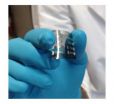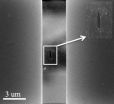(Press-News.org) It is a requirement of the touchscreens for all our everyday gadgets that they are transparent and at the same time electrically conductive. Solar cells are also unable to operate without such a film, which allows sunlight to pass through it, but can also conduct the current generated. Conventional "transparent conductive oxide" (TCO) films consist of a mixture of indium and tin oxide. Indium in very much in demand in the electronics industry, but is rare, and therefore expensive.
A cheaper option (at least in terms of the materials used) employs zinc oxide mixed with aluminium, which is usually applied to the substrate in a high vacuum by means of plasma sputtering. However, the manufacturing process is complex, making it similarly expensive. In addition, it is energy-intensive and therefore not ideal from an ecological perspective. Empa researchers at the Laboratory for Thin Films and Photovoltaics have now developed a water-based method of applying a TCO film made of aluminium and zinc salts onto a substrate – without a vacuum.
Less energy consumption
Another advantage of the new method is that during the last stage of production, in which the TCO film is "cured", the substrate does not have to be heated to 400 to 600 degrees as was previously the case, but only to 90 degrees. "This means that our method is not only cheaper and more environmentally friendly, but also requires less energy and it is even possible to use more heat-sensitive substrates, such as flexible plastics", explains Harald Hagendorfer from the research team.
The biggest difference, however, lies in the principle behind the manufacturing process. Whereas with the sputtering method, the TCO film is deposited onto the substrate in a high vacuum using a high-energy plasma, with the Empa method, this occurs through a type of molecular self-organisation. Thus, the TCO film grows "by itself" - with no subsequent high-temperature thermal treatment. A short irradiation process with a UV lamp is sufficient to produce excellent conductivity.
Yet here too, a problem had to be overcome: aluminium zinc oxide (AZO) prefers to grow tapering upwards - like stalagmites in a limestone cave. For optimum conductivity, however, there must be no gaps between the "pillars". The simple solution devised by the Empa team was to use a "molecular lid" during the crystal growing process. Thus, the material can only grow to a limited height and instead grows widthways, resulting in a compact film which is transparent and has optimum conductivity.
TCO films to become even more efficient
The Empa team, led by Ayodhya Tiwari, is now working to further improve the AZO films. In terms of electrical conductivity and transparency, they can already compete with indium-containing TCO films, but some optimisation is still required with regard to their use in solar cells. Tiwari and his colleagues want to reduce the TCO film thickness from one to two microns to just a few hundred nanometres. This would allow the AZO films to be used in flexible solar cells, further reducing the amount of material used. Tiwari's team is also currently working with another Empa research group on the indium-free production of organic solar cells, which would make the process cheaper and more sustainable. There certainly seems to be a considerable amount of interest in the new method. Industrial project partners are already on board, opening up the possibility that Empa TCO films may soon be manufactured on a large scale.
INFORMATION: END
In a commanding position -- and now cheaper
Environmentally friendly production method for transparent conductive films
2014-04-29
ELSE PRESS RELEASES FROM THIS DATE:
Study highlights importance of parents talking to kids about money
2014-04-29
A new study from North Carolina State University and the University of Texas finds that children pay close attention to issues related to money, and that parents should make an effort to talk with their children to ensure that kids don't develop misconceptions about finance.
"We wanted to know what kids are learning, or not learning, about money from their parents," says Dr. Lynsey Romo, an assistant professor of communication at NC State and lead author of a paper on the research. "This is one of the first studies to look at what young school-age children know about ...
Man landing on Madeira could be 4 centuries prior to its colonization by the Portuguese
2014-04-29
VIDEO:
Four centuries before its colonization by the Portuguese, man may have landed on Madeira Island. This can be deduced from a study led by the Spanish National Research Council (CSIC),...
Click here for more information.
According to the results, published in the Proceedings of the Royal Society B journal, house mice may have landed on the island before 1036, most likely transported by a ship. The article suggests that the introduction of this species would result in an ...
Immunology touted as next big thing for popular science
2014-04-29
A University of Manchester professor says scientific jargon could be making the science of the human immune system a turn-off for the general public.
Professor Daniel Davis says that scientists are using a number of innovative ways to generate public discussion on immunology and the time is right for people to get to grips with the subject.
His paper, published today in Nature Reviews Immunology, coincides with the International Day of Immunology, argues that now is the right time for immunology to become the next big trend in popular science – to inform new discussions ...
Nutrition experts chew the fat at ASN satellite symposium
2014-04-29
(San Diego, CA) April 25, 2014 – More research is needed to better understand the important role that dietary fats play in optimal health, said a panel of leading food and nutrition scientists Friday at an American Society for Nutrition (ASN) pre-annual meeting session.
More than 130 academic and industry food and nutrition scientists and registered dietitians attended the half-day ASN Satellite Symposium: Let's Chew the Fat: Current Thinking on Dietary Fats and the Food We Eat, held from 1-5 pm at the San Diego Bayfront Hilton in conjunction with the ASN's 78th Scientific ...
Adhesion molecule shows promise for treating colitis
2014-04-29
Philadelphia, PA, April 28, 2014 – The adhesion molecule CD146 plays a vital role in inflammation and offers a promising therapeutic target for treating inflammatory bowel disease (IBD) as well as preventing colitis-associated colorectal cancer, say scientists. Targeting CD146 with anti-CD146 antibody AA98, especially in combination with an anti-TNF-alpha antibody, showed promising results in mice. Their report is published in The American Journal of Pathology.
Enhanced CD146 expression has been reported on endothelial cells in intestinal biopsies from patients with inflammatory ...
'Let it go,' but not in the boardroom
2014-04-29
While Disney's Frozen Academy Award-winning diva anthem "Let It Go" has dominated the Billboard 200, sales records and parents' eardrums with its message of all-out emotional display, that approach probably won't always resonate in the boardroom, according to a recent study from Marshall and USC faculty.
"A business person in a negotiation," said Peter Carnevale, professor of management and organization at USC's Marshall School of Business, "should be careful about managing his or her emotions because the person across the table is making inferences based on facial expressions. ...
Graphene only as strong as weakest link
2014-04-29
HOUSTON – (April 29, 2014) – There is no disputing graphene is strong. But new research by Rice University and the Georgia Institute of Technology should prompt manufacturers to look a little deeper as they consider the miracle material for applications.
The atom-thick sheet of carbon discovered this century is touted not just for its electrical properties but also for its physical strength and flexibility. The bonds between carbon atoms are well known as the strongest in nature, so a perfect sheet of graphene should withstand just about anything. Reinforcing composite ...
Urban river pollutants suppress wild bird development
2014-04-29
New research indicates that hormone disrupting pollutants are affecting the health and development of wild birds nesting along the urban rivers of South Wales.
Findings published today in the Environmental Toxicology and Chemistry journal reveal that chicks of the Eurasian Dipper – a river bird that feeds exclusively on insects and fish in upland streams – are underweight compared to their rural counterparts. Also of concern is that birds nesting in urban rivers have altered hormone levels, and are hatching fewer female chicks than those nesting along rural rivers, ...
'Lonely' bacteria increase risk of antibiotic resistance
2014-04-29
Scientists from The University of Manchester have discovered that 'lonely' microbes are more likely to mutate, resulting in higher rates of antibiotic resistance.
The study, published today in Nature Communications and jointly funded by The Wellcome Trust and Engineering and Physical Sciences Research Council, explored the mutation rates of E. coli.
Researchers found out that the rate of mutation varied according to how many of the bacteria there were. Surprisingly, they discovered that more bacteria gave fewer mutations.
Meanwhile more 'lonely' bacteria developed ...
Research sees overlap in genes altered in schizophrenia, autism, intellectual disability
2014-04-29
Dublin, Ireland and Cold Spring Harbor, NY – In research published today in Molecular Psychiatry, a multinational team of scientists presents new evidence supporting the theory that in at least some cases of schizophrenia, autism and intellectual disability (ID), malfunctions in some of the same genes are contributing to pathology.
The team, the product of an ongoing collaboration between Professors W. Richard McCombie of Cold Spring Harbor Laboratory (CSHL) and Aiden Corvin of Trinity College, Dublin, studied a type of gene aberration called de novo mutation, in a ...
LAST 30 PRESS RELEASES:
Tracing the quick synthesis of an industrially important catalyst
New software sheds light on cancer’s hidden genetic networks
UT Health San Antonio awarded $3 million in CPRIT grants to bolster cancer research and prevention efforts in South Texas
Third symposium spotlights global challenge of new contaminants in China’s fight against pollution
From straw to soil harmony: International team reveals how biochar supercharges carbon-smart farming
Myeloma: How AI is redrawing the map of cancer care
Manhattan E. Charurat, Ph.D., MHS invested as the Homer and Martha Gudelsky Distinguished Professor in Medicine at the University of Maryland School of Medicine
Insilico Medicine’s Pharma.AI Q4 Winter Launch Recap: Revolutionizing drug discovery with cutting-edge AI innovations, accelerating the path to pharmaceutical superintelligence
Nanoplastics have diet-dependent impacts on digestive system health
Brain neuron death occurs throughout life and increases with age, a natural human protein drug may halt neuron death in Alzheimer’s disease
SPIE and CLP announce the recipients of the 2025 Advanced Photonics Young Innovator Award
Lessons from the Caldor Fire’s Christmas Valley ‘Miracle’
Ant societies rose by trading individual protection for collective power
Research reveals how ancient viral DNA shapes early embryonic development
A molecular gatekeeper that controls protein synthesis
New ‘cloaking device’ concept to shield sensitive tech from magnetic fields
Researchers show impact of mountain building and climate change on alpine biodiversity
Study models the transition from Neanderthals to modern humans in Europe
University of Phoenix College of Doctoral Studies releases white paper on AI-driven skilling to reduce burnout and restore worker autonomy
AIs fail at the game of visual “telephone”
The levers for a sustainable food system
Potential changes in US homelessness by ending federal support for housing first programs
Vulnerability of large language models to prompt injection when providing medical advice
Researchers develop new system for high-energy-density, long-life, multi-electron transfer bromine-based flow batteries
Ending federal support for housing first programs could increase U.S. homelessness by 5% in one year, new JAMA study finds
New research uncovers molecular ‘safety switch’ shielding cancers from immune attack
Bacteria resisting viral infection can still sink carbon to ocean floor
Younger biological age may increase depression risk in older women during COVID-19
Bharat Innovates 2026 National Basecamp Showcases India’s Most Promising Deep-Tech Ventures
Here’s what determines whether your income level rises or falls
[Press-News.org] In a commanding position -- and now cheaperEnvironmentally friendly production method for transparent conductive films


